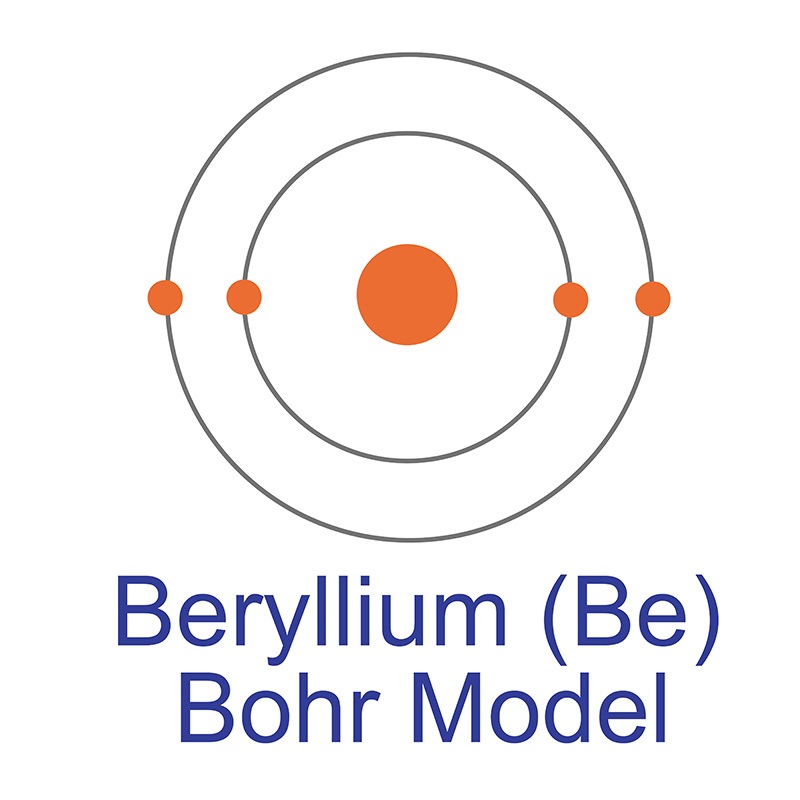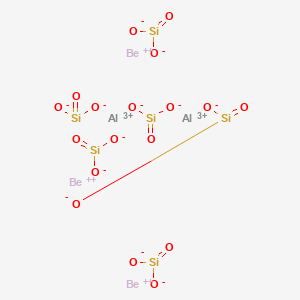SECTION 1. IDENTIFICATION
Product Name: Beryllium Aluminosilicate
Product Number: All applicable American Elements product codes, e.g. BE-ALSIAT-02-P
CAS #: 1302-52-9
Relevant identified uses of the substance: Scientific research and development
Supplier details:
American Elements
10884 Weyburn Ave.
Los Angeles, CA 90024
Tel: +1 310-208-0551
Fax: +1 310-208-0351
Emergency telephone number:
Domestic, North America: +1 800-424-9300
International: +1 703-527-3887
SECTION 2. HAZARDS IDENTIFICATION
Statement of Hazard: Irritant, Respiratory irritant, Toxic
Acute Health Hazard: Irritant to eyes, skin, mucous membranes and respiratory system.
May be toxic by ingestion, skin absorption and inhalation.
Chronic Health Hazard: Not Available
HMIS Rating:
H: 3
F: 0
P: 0
NFPA Rating:
H: 3
F: 0
R: 0
To the best of our knowledge, the toxicological properties of this chemical have not been
thoroughly investigated. Use appropriate procedures and precautions to prevent or minimize
exposure.
Pictogram:

Signal Word: Warning
Hazard Statement(s): H301 Toxic if swallowed.
H311 Toxic in contact with skin.
H315 Causes skin irritation.
H320 Causes eye irritation.
H331 Toxic if inhaled.
H335 May cause respiratory irritation.
Precautionary Statement(s): P261 Avoid breathing dust/fume/gas/mist/vapors/spray.
P264 Wash skin thoroughly after handling.
P270 Do not eat, drink, or smoke when using this product.
P271 Use only outdoors or in a well-ventilated area.
P280 Wear protective gloves/protective clothing/eye protection/face
protection.
P301+P310 IF SWALLOWED: Immediately call a POISON CENTER or
doctor/physician.
P302+P352 IF ON SKIN: wash with plenty of soap and water.
P304+P340 IF INHALED: Remove victim to fresh air and Keep at rest in a
position comfortable for breathing.
P305+P351+P338 IF IN EYES: Rinse cautiously with water for several
minutes. Remove contact lenses, if present and easy to do. Continue
rinsing.
P332+P313 IF SKIN irritation occurs: Get medical advice/attention.
P403+P233 Store in a well-ventilated place. Keep container tightly closed.
SECTION 3. COMPOSITION/INFORMATION ON INGREDIENTS
Chemical Name: Beryllium aluminum silicate
Synonyms: Beryl
CAS Number: 1302-52-9
MDL Number: MFCD00049838
EINECS Number: 215-101-7
Beilstein Registry Number: Not Available
Molecular Formula: Be3Al2(SiO3)6
Molecular Weight: 537.50
Content: As specified in product name.
SECTION 4. FIRST AID MEASURES
Eye Contact: Flush eyes with large amounts of water for fifteen minutes. Separate eyelids with fingers. If irritation persists, seek medical attention.
Skin Contact: Wash skin with soap and water. If irritation persists, seek medical attention.
Ingestion: Do not induce vomiting. Seek medical attention.
Inhalation: Move to a fresh air environment. Contact a physician if breathing becomes difficult.
SECTION 5. FIREFIGHTING MEASURES
Flash Point (ºC): Not Available
Explosion Limits: Not Available
Autoignition (ºC): Not Available
Extinguishing Media: Carbon dioxide, dry chemical powder, alcohol-resistant foam, or water
spray
Protective Equipment: Wear self-contained respirator and fully protective impervious suit.
Specific Hazards: May emit hazardous fumes under fire conditions.
SECTION 6. ACCIDENTAL RELEASE MEASURES
Personal Protection: Wear a self-contained breathing apparatus, rubber boots and gloves, and disposable coveralls. Dispose of coveralls after use. Remove from ignition sources if safe to do so. Follow emergency response plan and contact proper authorities if needed.
Keep unprotected persons away.
Environmental Protection: Keep spills out of sewers and bodies of water. Dike and contain the
spill with inert material. Absorb on sand, vermiculite or diatomite.
Transfer material to a container for disposal or recovery. Ventilate area and wash spill site after material pickup is complete.
SECTION 7. HANDLING AND STORAGE
Handling and Storage: Avoid breathing dust, vapor, mist or gas. Avoid contact with skin and eyes. Avoid prolonged or repeated exposure. Use only in a chemical fume hood. Open and handle container with care. Keep ignition sources away.
Store in a tightly closed container in a dry, well-ventilated place.
Sensitivities: Not Available
Storage Temperature (ºC): 15 to 30
SECTION 8. EXPOSURE CONTROLS/PERSONAL PROTECTION
Engineering Controls: Use product in a well ventilated area or under a fume hood. Use proper
lab equipment while handling this product. Keep away from incompatible materials for possible risk of hazardous reaction.
Eye Protection: Wear appropriate protective eyeglass or chemical safety goggles. Make sure that there is an eyewash station in your vicinity.
Skin Protection: Wear impervious gloves and protective clothing.
Respiratory Protection: Use a NIOSH approved respirator when exposure limits are exceeded or
if irritation or other symptoms are experienced.
Exposure Limits:
Country Source Type Value
USA ACGIH TWA Not Available
USA OSHA STEL Not Available
USA OSHA PEL Not Available
SECTION 9. PHYSICAL AND CHEMICAL PROPERTIES
Appearance: Crystals
Odor: Not Available
Odor Threshold: Not Available
Flash Point (ºC): Not Available
Auto Ignition
Temperature (ºC): Not Available
UEL % by Volume: Not Available
LEL % by Volume: Not Available
Melting Point (ºC): 1410
Boiling Point (ºC): Not Available
Evaporation Rate: Not Available
pH Value: Not Available
Density (g/cm3): 2.66
Refractive Index (n²ºD): Not Available
Viscosity: Not Available
Solubility in Water: Not Available
Solubility in Other: Not Available
Vapor Pressure (mmHg): Not Available
Vapor Density (Air=1): Not Available
SECTION 10. STABILITY AND REACTIVITY
Stability: Stable under normal temperatures and pressures.
Incompatibility: Strong oxidizing agents, alkali metals
Reactivity: Product may react with incompatible materials to release other hazardous substances.
Conditions to Avoid: Heat, flame, sparks, other ignition sources.
Hazardous Decomposition Products: Aluminum oxides, Beryllium oxides, Silicon oxides
SECTION 11. TOXICOLOGICAL INFORMATION
RTECS Reference: Not Available
Target Organs: Not Available
Toxicity Data: Not Available
Carcinogenicity: National Toxicology Program (NTP) listed: Not Available
International Agency for Research on Cancer (IARC) listed: Not Available
Potential Symptoms: Not Available
SECTION 12. ECOLOGICAL INFORMATION
Toxicity: Not Available
SECTION 13. DISPOSAL CONSIDERATIONS
Contact a licensed professional waste disposal service. Dispose in a manner consistent with
federal, state and local environmental regulations.
SECTION 14. TRANSPORT INFORMATION
DOT Shipping Name: Beryllium Compound, N.O.S.
DOT UN Number: UN1566
DOT Hazard Class: Class 6.1
DOT Packing Group: III
IMDG Shipping Name: Beryllium Compound, N.O.S.
IMDG UN Number: UN1566
IMDG Hazard Class: Class 6.1
IMDG Packing Group: III
Marine Pollutant: No
IATA: Not permitted for air transport
SECTION 15. REGULATORY INFORMATION
United States
Toxic Substance Control Act (TSCA) listed: Yes
Superfund Amendments and Reauthorization Act (SARA 302) listed: No
Superfund Amendments and Reauthorization Act (SARA 311/312) listed: No
Superfund Amendments and Reauthorization Act (SARA 313) listed: Not Available
European Union
European Inventory of Existing Chemical Substances (EINECS): 215-101-7
Canada
Canadian Non-Domestic Substances List (NDSL) listed: Yes
Toxic Substance Control Act (TSCA) listed: Yes
Superfund Amendments and Reauthorization Act (SARA 302) listed: No
Superfund Amendments and Reauthorization Act (SARA 311/312) listed: No
Canadian Domestic Substances List (DSL) listed: No
SECTION 16. OTHER INFORMATION
Safety Data Sheet according to Regulation (EC) No. 1907/2006 (REACH). The above information is believed to be correct but does not purport to be all inclusive and shall be used only as a guide. The information in this document is based on the present state of our knowledge and is applicable to the product with regard to appropriate safety precautions. It does not represent any guarantee of the properties of the product. American Elements shall not be held liable for any damage resulting from handling or from contact with the above product. See reverse side of invoice or packing slip for additional terms and conditions of sale. COPYRIGHT 1997-2022 AMERICAN ELEMENTS. LICENSED GRANTED TO MAKE UNLIMITED PAPER COPIES FOR INTERNAL USE ONLY.
 Aluminum's name is derived from alumina, the mineral from which Sir Humphrey Davy attempted to refine it from in 1812. Aluminum was first predicted by Antoine Lavoisier 1787 and first isolated by Hans Christian Øersted in 1825. Aluminum is a silvery gray metal that possesses many desirable characteristics. It is light, nonmagnetic and non-sparking. It stands second among metals in the scale of malleability, and sixth in ductility. It is extensively used in many industrial applications where a strong, light, easily constructed material is needed.
Aluminum's name is derived from alumina, the mineral from which Sir Humphrey Davy attempted to refine it from in 1812. Aluminum was first predicted by Antoine Lavoisier 1787 and first isolated by Hans Christian Øersted in 1825. Aluminum is a silvery gray metal that possesses many desirable characteristics. It is light, nonmagnetic and non-sparking. It stands second among metals in the scale of malleability, and sixth in ductility. It is extensively used in many industrial applications where a strong, light, easily constructed material is needed.  Although it has only 60% of the electrical conductivity of copper, it is used in electrical transmission lines because of its light weight. Pure aluminum is soft and lacks strength, but alloyed with small amounts of copper, magnesium, silicon, manganese, or other elements, it imparts a variety of useful properties.
Although it has only 60% of the electrical conductivity of copper, it is used in electrical transmission lines because of its light weight. Pure aluminum is soft and lacks strength, but alloyed with small amounts of copper, magnesium, silicon, manganese, or other elements, it imparts a variety of useful properties. The number of electrons in each of Beryllium's shells is [2, 2] and its electron configuration is [He] 2s2. The beryllium atom has a radius of 112 pm and a Van der Waals radius of 153 pm. Beryllium is a relatively rare element in the earth's crust; it can be found in minerals such as bertrandite, chrysoberyl, phenakite, and beryl, its most common source for commercial production. Beryllium was discovered by Louis Nicolas Vauquelin in 1797 and first isolated by Friedrich Wöhler and Antoine Bussy in 1828.
The number of electrons in each of Beryllium's shells is [2, 2] and its electron configuration is [He] 2s2. The beryllium atom has a radius of 112 pm and a Van der Waals radius of 153 pm. Beryllium is a relatively rare element in the earth's crust; it can be found in minerals such as bertrandite, chrysoberyl, phenakite, and beryl, its most common source for commercial production. Beryllium was discovered by Louis Nicolas Vauquelin in 1797 and first isolated by Friedrich Wöhler and Antoine Bussy in 1828.  In its elemental form, beryllium has a gray metallic appearance. It is a soft
In its elemental form, beryllium has a gray metallic appearance. It is a soft 
